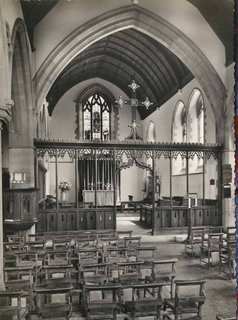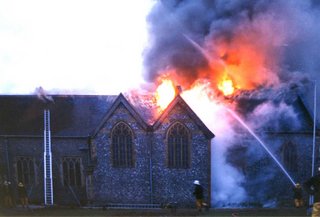History
 Built in 1913
Built in 1913
St John the Evangelist Church Hurst Green was consecrated in 1913 and was the daughter church of the old Parish of St Mary the Virgin, Oxted. It was built to meet the needs of the growing population of what was originally the tiny hamlet of Hurst Green. The church has a tower, chancel, nave and Lady Chapel. It is faced with sandstone from a quarry near Tunbridge Wells and with knapped flint from the chalk pits of the North Downs. Inside winkle marble from Bletchingley decorates the floor of the sanctuary.
Extended in 1962
The west end of the church was incomplete when it was built because it was always expected that it would be extended. This finally happened and provided a longer nave, baptistry, porch, kitchen, toilets and meeting room known as St John's Room. The porch is floored with York stone that had originally been London paving stones and, at the far end, winkle marble matching that of the sanctuary. A fine, circular rose window in stained glass was installed in the west wall with panels depicting themes connected with the patron saint, St John the Evangelist.
The fire in 1988
 On Good Friday 1988 the entire roof and interior of the church were destroyed by fire resulting from arson. A two-year rebuilding programme took place which also included some reordering of the interior:
On Good Friday 1988 the entire roof and interior of the church were destroyed by fire resulting from arson. A two-year rebuilding programme took place which also included some reordering of the interior:
-
The rood screen between the chancel and the sanctuary was removed and now forms the wall of the choir vestry in the north transept.
-
The large wooden cross from the top of the screen was placed on the wall beneath the east window.
-
-
The high altar was moved to the centre of the sanctuary and the choir stalls were repositioned along the east wall.
-
The aisles and entire chancel were carpeted.
-
The old pipe organ was replaced by a 3-manual electronic instrument.
-
Two new meeting rooms were created in the tower.
The restored church was rededicated on Easter Day 1990.
The York Rooms opened in 2010
By 2005 St John's was once more becoming too small for the use demanded of it. Plans were made for another extension, this time on the north side to provide a large room capable of division into three smaller rooms, for activities in addition to worship. Fundraising took off in earnest and many community events were enjoyed for this purpose. Work started in May 2009 and on 21 March 2010 The York Rooms were opened and dedicated.
Windows and Art
The large east window shows the risen Christ in glory, flanked on one side, by the Virgin Mary, and on the other, by St John the Evangelist.
There is a fine, circular rose window in the west wall in stained glass, with panels depicting themes connected with the patron saint, St John the Evangelist.
Of particular interest in the church are two painted mural panels by the artist, John Hayward. One is in the Lady Chapel entitled 'The Annunciation', the other, 'The Virgin and Child' is in the baptistry. Also, on the south wall is a fine carving of an eagle, the traditional symbol of St John the Evangelist.
Church Grounds
The church is surrounded by extensive grounds which provide a very attractive setting.
A drive runs around the grassy central area which features a rose bed and from which the overflow car park can be accessed.
The churchyard of St John's, like so many others, was derived from ancient meadowland and it was a delight to discover a purple spotted orchid in bloom there. In 1997, it was decided to designate the left hand side of the churchyard a conservation area with the aim of protecting the orchid and introducing and encouraging other wild plant species. A variety of grasses and colourful wildflowers flourish including violets, primroses, fritillaries, cowslips, ox-eye daisies and red campion in addition to the orchid which has continued to flourish.
The Memorial Garden can be found on the right-hand side of the churchyard. (include a hyperlink to this to the funeral section where info re the memorial garden should be stored).
On the northwest side of the church there is a small patio and grass bank topped with colourful flowering shrubs.